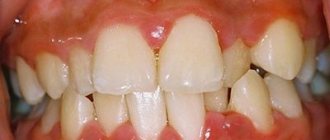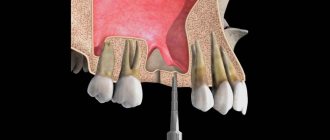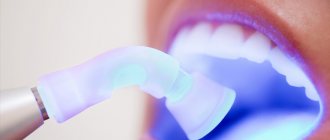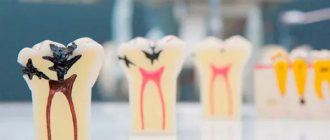Alcohol after dental treatment
The effect of alcohol on a treated tooth
How long after dental treatment can you drink alcohol?
Is it possible to drink carbonated or foamy drinks after dental treatment?
Is it possible to smoke after surgery?
A toothache can strike at the most unexpected moment, including before a planned feast. Is it possible to drink alcohol after dental treatment? What consequences can this lead to?
How long should you not eat after having a filling installed?
If a filling made of chemical composites is installed, then you should refrain from eating and drinking for 2 hours. This is due to the fact that the material requires a certain time for final shrinkage and hardening.
If a “light” composite filling is installed, you can drink immediately, but you should abstain from food for 1.5-2 hours. But the reason is not in the material (it hardens a few seconds after application), but in anesthesia - with reduced sensitivity of the mucous membranes during eating, you can injure the tongue and mucous membranes of the cheeks on the inside.
During the day after the filling is installed, you should only eat warm foods - excessively hot or cold foods can lead to changes in the shape of the filling. It is necessary to chew food on the opposite side for the first day - this will allow the material to fully “adhere” to the tissues and take the desired shape, without the risk of damage.
The effect of alcohol on a treated tooth
Some people think that alcohol after dental treatment additionally disinfects the oral cavity, but doctors say the opposite. After dental treatment, especially after treatment of pulpitis or periodontitis, the body needs rest. Not only the daily routine should be gentle, but also the diet, so at this time it is better to give up alcoholic beverages.
Let's tell you why.
- Alcohol can cause bleeding because alcohol dilates blood vessels and increases blood pressure.
- When drinking alcohol, the oral mucosa is irritated, the healing process slows down, and the risk of inflammation increases.
- Alcohol increases the load on the cardiovascular system and liver.
- Alcoholic drinks in combination with an anesthetic can cause headache, weakness, and convulsions.
Despite the fact that the effect of anesthesia wears off on average after two hours, the breakdown products continue to remain in the body for several more days.
Alcohol before surgery: possible consequences
The strict ban on drinking alcohol before tooth extraction is due to many factors that can have an extremely negative impact on both the patient’s health and the course of the operation. You can see a number of problems below.
- Weak or completely absent effect of anesthesia;
- The recovery process after surgery takes much longer;
- Increased risk of inflammatory processes;
- Intoxication and the body’s rejecting reaction to medications.
IMPORTANT!
If a patient comes to an appointment while intoxicated, the doctor has the right to refuse admission. This is due to the fact that a drunk person can negatively affect the progress of the operation.
Is it possible to drink carbonated or foamy drinks after dental treatment?
Gas is a constant irritant to the tooth, and foamy drinks (for example, kvass) contain yeast, which can get into the wound and cause discomfort. In addition, in the first days after tooth extraction, it is not recommended to drink drinks from straws. When sucking any drink, a vacuum is created in the mouth, which can tear a blood clot out of the hole.
If the doctor has placed a temporary filling
A temporary filling is made of a fragile material and is placed for several days to close the tooth cavity with the medicine placed inside. The patient’s task is not to damage the temporary filling until the next visit to the dentist:
- teeth are brushed with care; the pressure of the toothbrush on the tooth on which the temporary filling is placed should be minimal;
- It is better to exclude very hot and very cold foods and drinks. You cannot eat hot and cold at the same time;
- The chewing load on the filled tooth should be limited; it is better not to chew food with it, if possible.
Types of light seals
The dentist chooses a photopolymer material depending on the location of the tooth and the task at hand - will it be caries therapy or the elimination of a non-carious defect on a unit.
There are 3 types of material:
- consisting of large particles - preferable for chewing molars, such a filling will be resistant to abrasion;
- consisting of microparticles - relevant in the case of treating caries on the front teeth and restoring the aesthetics of the units;
- nanocomposite - durable, reliable, aesthetic, but has a higher cost.
Before deciding to install a light filling, the doctor will definitely evaluate the location of the caries. If the lesion is in a hard-to-reach place, you will have to choose another material due to the impossibility of high-quality polymerization.
Watch your diet!
Fatty foods and spices should not be on the menu during the rehabilitation period. If the patient is accustomed to such a diet, it is especially difficult for him to give up taste preferences. It is important to know: alcohol weakens people’s control over their actions and whets their appetite. Harmful bacteria enter the oral cavity along with foods consumed after surgery.
Spicy food causes irritation and chemical burns to the tissues of the oral cavity. But she requires special care during the rehabilitation period! Substances contained in alcoholic beverages cause pain in the mouth, sepsis, and swelling. Thus, eating habits and momentary pleasure put health and life at risk.
This article was checked and approved by the doctor Eduard Gennadievich Reunin.
Advantages of photopolymer material
This differs from other types of composite materials:
- The ability to control the hardening process. The doctor fills the tooth without haste, applying layers of material as carefully as possible. The composition is plastic, hardens only when exposed to an ultraviolet lamp.
- Safety for the patient's health. Photopolymer material is characterized by low toxicity, so it is used even in pediatric dentistry.
- The ability to create a filling of the desired shade. She won't stand out.
- Durability. It is due to good adhesion to hard tissues. Typically, the service life of a photopolymer filling is at least 5 years. With careful handling and high-quality teeth cleaning, its service life increases.
- Ease of finishing. The composite can be polished well, so the filling does not create discomfort - it will not scratch the mucous membrane of the tongue and cheeks.
An experienced dentist can easily give the crown the desired shape, so the filled tooth looks natural.
What is a light seal?
The photopolymer composite material that the dentist uses consists of a mixture of resins, silanes and filler.
It hardens when exposed to ultraviolet radiation, so when filling a tooth, the doctor uses a special lamp that creates waves with a length of 450 Nm in the blue spectrum. For a high-quality result, he applies the composite material layer by layer, exposing each layer to light. At this stage, primary polymerization occurs. Then, within 24 hours, the chemical bonds stabilize and the filling finally hardens. In this regard, the doctor gives certain recommendations, compliance with which guarantees the durability of the material - the filling lasts 5 years or more.
Recommendations
All alcoholic drinks contain ethyl alcohol. If you drink vodka, wine, cognac or beer, the liver takes on double the load. The body needs to absorb both the painkiller and the alcohol. The negative impact on the liver can be aggravated by the use of antibiotics, analgesics, and antihistamines. To avoid toxic shock, you need to follow these tips:
- You should avoid drinking alcohol if you are planning a dental visit on the same day.
- If your dental procedure involves the use of antibiotics, it is best to avoid drinking alcoholic beverages throughout the treatment.
- Before the appointment, it is necessary to inform the dentist about the presence of allergic reactions and medications used the day before.
- Remember that the success of a medical procedure depends on proper preparation. If you approach dental surgery irresponsibly, you may need additional anesthesia or repeated intervention.
There is no doubt that drinking strong drinks during dental anesthesia is extremely undesirable. If you want the procedure to be safe and painless, you should carefully read the above recommendations.
Don't be afraid of visiting the dentist's office. You can consult a competent specialist who will tell you how to properly prepare for the treatment process. A professional dentist will select an individual anesthetic and recommend the most effective method for a quick recovery.
Category Miscellaneous Published by kosmetik-dent
How long should you abstain from alcohol?
To avoid dangerous consequences for the body, before visiting the dentist and after procedures with anesthesia, you need to refrain from drinking alcoholic beverages. After medical manipulations, at least 1-2 days should pass before the person drinks alcohol.
Why can our articles be trusted?
We make health information clear, accessible and relevant.
- All articles are checked by practicing doctors.
- We take scientific literature and the latest research as a basis.
- We publish detailed articles that answer all questions.
If the planned event requires a person to drink, then it is better to limit yourself to a glass of wine or one glass of vodka. This will not have a significant effect on the body and will prevent possible negative consequences. But again, you need to drink this amount of alcohol no less than a few hours after dental anesthesia.
What to do if your gums hurt after filling
The gums in the area where the anesthesia was administered may ache for several days - this is completely normal and does not require any measures. The mucous membrane may also be slightly inflamed if special rings were used during treatment, which are placed on the tooth to form the correct shape of its crown. The gums can also be damaged if the doctor had to install the filling material in close proximity to the mucous membrane or even under it - in such a situation the gums are deliberately pushed back. Therefore, pain is a normal reaction to external intervention.
All of these conditions are variations of the norm. But if the pain intensifies, redness and swelling of the mucous membrane progresses, you need to consult a doctor.
How to maintain your treatment guarantee
To maintain the guarantee, the patient must strictly follow all recommendations: do not overload the tooth, do not use it for other purposes (for example, opening beer bottles, biting off threads), and also regularly see the doctor in accordance with the individual schedule of medical examinations, approximately once every six months. Unfortunately, many patients forget about this, and it is the last point that is the key to maintaining the guarantee for treatment.
You need to visit a doctor 1-2 times a year. During a preventive examination, the dentist will be able to make sure that the filling is in good condition, and that secondary caries does not develop again under it.
How to properly perform hygiene procedures
After treatment, brush the filled tooth carefully, applying minimal pressure to it. Do not use rinses containing abrasive substances and alcohol, which can increase the plasticity of the material - this will lead to a change in the shape of the filling. Also, do not use overly hard brushes - they can leave microcracks in the material, which will not have the best effect on the durability of the filling.
In general, you should take care of teeth with fillings in a completely standard way:
- daily brushing of teeth twice a day - in the morning after breakfast and in the evening after all meals, after - rinsing the mouth with water and rinse,
- To clean the area of filled teeth after eating, it is better to replace dental floss with an irrigator. If you floss (thread) carelessly, you can touch the installed filling, especially if there are thin edges of the tooth, which will lead to its chipping or loss.











